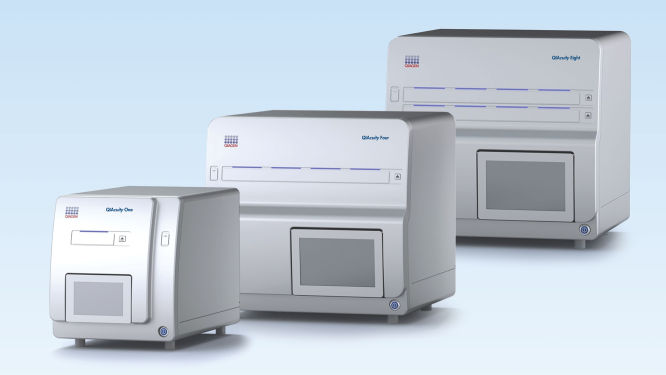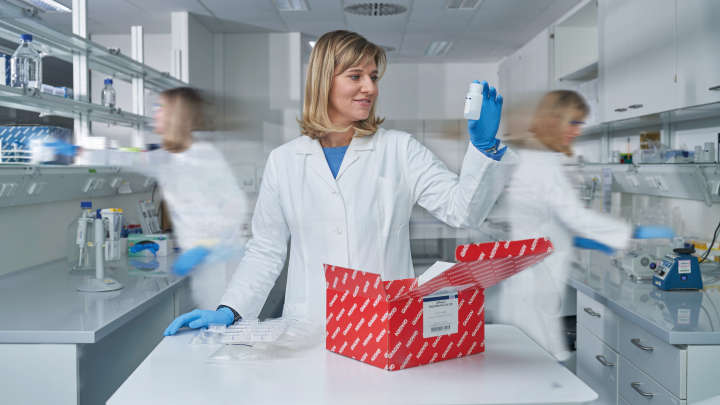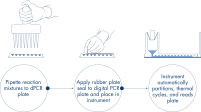
QIAcuity One, 2plex System
Kat.-Nr. / ID. 911002
Eigenschaften
- Vollintegriertes System
- Skalierbares Format (Geräte mit 1, 4 und 8 Platten)
- Erweiterte Multiplexing-Fähigkeiten (bis zu 12-plex)
- Bis zu sechs Standardkanäle plus zwei Hybridkanäle für LSS-Farbstoffe
- Flexibler Probendurchsatz
- Umfassende Ergebnisse in ca. 2 Stunden
Angaben zum Produkt
Das QIAcuity Digital PCR System liefert präzise und multiplexe Quantifizierungsergebnisse für den Nachweis von Mutationen, Kopienzahlvariation (Copy Number Variation, CNV), Genexpressionsstudien, Gen-Editing-Analysen und vieles mehr. Dieses auf Nanoplatten basierende System integriert nahtlos einen dPCR-Standardworkflow mit Partitionierung, Thermocycling und Bildgebung in einer vollautomatischen Plattform mit minimalem Zeitaufwand für den Benutzer.
Das System wird zusammen mit QIAcuity Nanoplates, Reagenzien und Assays verwendet.
In der virtuellen Demo können Sie mehr über QIAcuity erfahren.
Leistung
Das QIAcuity Digital PCR System macht die absolute Quantifizierung für alle Labore zugänglich und erschwinglich. Die Vollautomatik integriert und optimiert den gesamten digitalen PCR-Workflow von Partitionierung, Thermocycling und Bildgebung in einem einzigen Gerät und das bei minimalem Zeitaufwand für den Benutzer. Darüber hinaus lassen sich Ihre aktuellen qPCR-Assays leicht an das QIAcuity Digital PCR System anpassen. Beim Umstieg von der qPCR ist keine Änderung der Plattenhandhabung erforderlich, was eine schnelle Assay-Konfiguration und rasche Ergebnisse in ca. 2 Stunden gewährleistet.
QIAcuity-Geräte – Eigenschaften und Spezifikationen
| Eigenschaft | QIAcuity One 2plex | QIAcuity One 5plex | QIAcuity Four | QIAcuity Eight |
|---|---|---|---|---|
| Anzahl verarbeiteter Platten | 1 | 1 | 4 | 8 |
| Detektionskanäle | 2 | 81) (6+2 hybrid2) |
81) (6+2 hybrid2) |
81) (6+2 hybrid2) |
| Multiplexing-Fähigkeit | 4 | 123)1) | 123)1) | 123)1) |
| Thermocycler | 1 | 1 | 1 | 2 |
| Zeit bis zum Ergebnis | Ca. 2 Std. | Ca. 2 Std. |
Erste Platte ca. 2 Std. Alle ∼80 min eine weitere Platte |
Erste Platte ca. 2 Std. Alle ∼40 min eine weitere Platte |
| Durchsatz (verarbeitete Proben an einem Arbeitstag) |
Bis zu 384 (96-Well) Bis zu 96 (24-Well) |
Bis zu 384 (96-Well) Bis zu 96 (24-Well) |
Bis zu 672 (96-Well) Bis zu 168 (24-Well) |
Bis zu 1248 (96-Well) Bis zu 312 (24-Well) |
1) Erfordert die Verwendung des QIAcuity High Multiplex Probe PCR Kit bei Multiplexing >5plex
2) Hybridkanäle werden für Long Stokes Shift (LSS)-Farbstoffe verwendet
3) Die parallele Erkennung von 12 Zielen kann durch Amplituden-Multiplexing in den sechs Standardkanälen erreicht werden. Durch die Kombination von Hybridkanälen für Singleplex-LSS-Farbstoffe und Amplituden-Multiplexing lässt sich die Gesamtzahl möglicher Multiplexe auf 14 erhöhen. Aufgrund des Optimierungsbedarfs für alle in einem Reaktionsmix verwendeten Assays und der entsprechenden Crosstalk-Kompensation wird diese Kombination jedoch nicht empfohlen.
Prinzip
In nur 3 einfachen Schritten erhalten Sie in ca. 2 Stunden das gewünschte dPCR-Ergebnis: pipettieren und laden, Experiment durchführen, Ergebnisse auswerten.
Das Prinzip der dPCR-Reaktion in den Nanoplatten finden Sie hier beschrieben.
Verfahren
Genau wie bei qPCR-Experimenten umfasst die Probenvorbereitung die Überführung von Master-Mix, Sonden und Primern in eine 96- oder 24-Well-Nanoplatte, gefolgt von der Zugabe der Proben. Das System integriert Partitionierung, Thermocycling und Bildgebung in nur einem vollautomatischen Gerät, mit dem Sie in weniger als 2 Stunden von der Probe zum Ergebnis gelangen. Mit der Software Suite lassen sich Auswertungen durchführen, die die Konzentration der Zielsequenz in Kopien pro Mikroliter für Ihre Zielsequenz sowie für Qualitätskontrollen wie positive Proben und NTC liefern. Diese Auswertung kann auch auf Remote-Computer innerhalb desselben lokalen Netzwerks (LAN) ausgedehnt werden.
Anwendungen
Zusammen mit den QIAcuity Nanoplates und QIAcuity PCR Kits ermöglichen die QIAcuity-Geräte digitale PCR-Anwendungen, darunter:
- Nachweis seltener Mutationen
- Analyse von Kopienzahlvariationen
- Genexpressionsanalyse
- Pathogennachweis
- Genotypisierung
- miRNA-Forschung
- Zell- und Gentherapie
Software
Die mit dem Gerät gelieferte und auf einem separaten Computer installierte QIAcuity Software Suite steuert ein oder mehrere QIAcuity-Geräte, die entweder direkt mit einem Gerät verbunden sind oder ein vorhandenes lokales Netzwerk (LAN) nutzen. Mit der QIAcuity Software Suite können digitale PCR-Experimente, Proben und Reaktionsmischungen definiert, Nanoplatten zugeordnet und auf das QIAcuity-Gerät übertragen werden. Nach dem Gerätedurchlauf können die Daten analysiert, Berichte erstellt und die Daten zur externen Auswertung exportiert werden. Die Software bietet multiple Template-Funktionen, um sich wiederholende Plattenlayouts und Plattenlaufparameter leicht aufrufen zu können und so Ihre Erfahrung mit der digitalen PCR weiter zu optimieren.
Bei Integration in ein lokales Netzwerk dient der Computer, auf dem die QIAcuity Software Suite installiert ist, als Server, auf den andere Computer als Clients über das LAN zugreifen können. So können mehrere Benutzer von anderen Räumen oder Büros aus auf die Software zugreifen und Daten über einen Standardbrowser analysieren, ohne dass die Software auf mehreren Computern installiert werden muss oder der Zugriff und Austausch von Daten über Internetverbindungen benötigt wird.
Services
Schützen Sie Ihr Gerät mit den vielfältigen Servicelösungen von QIAGEN. Erfahren Sie mehr über spezifisch auf Ihre Bedürfnisse abgestimmte Serviceverträge.
Ergänzende Daten und Abbildungen
Ein einfacher und schneller plattenbasierter Workflow.

Service-Pläne
QIAcuity One 2plex Full Agreement
Kat.-Nr. / ID. 9245362
QIAcuity One 2plex Basic Agreement
Kat.-Nr. / ID. 9245401
QIAcuity One 5plex Basic Agreement
Kat.-Nr. / ID. 9245402
QIAcuity Eight Basic Agreement
Kat.-Nr. / ID. 9245404
QIAcuity One 5plex Full Agreement
Kat.-Nr. / ID. 9245363









